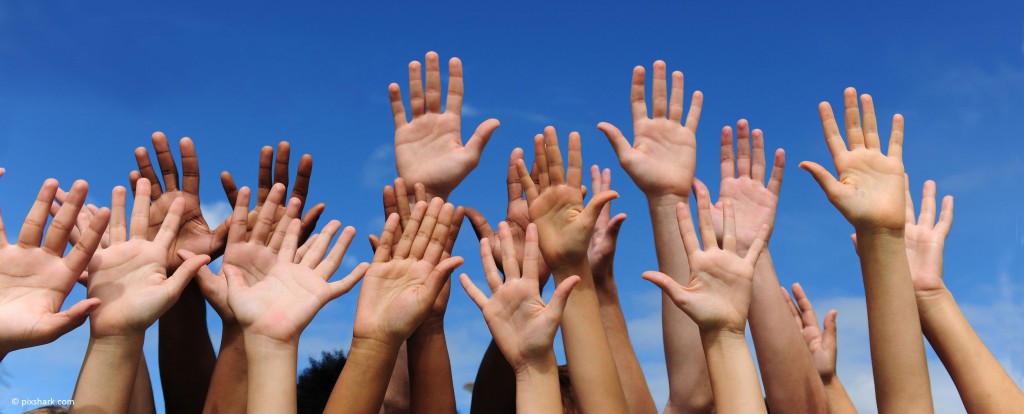
If you want people to engage with you, you will need to create opportunity for participation; it’s how engagement is ‘paid’ for. As I like to say, participation is the currency of engagement.
However, a recurring mistake with participation is to expect too little or too much:
- Ask for too much participation, and fatigue quickly sets in. (I call this the overestimation of participation, and it’s a perennial problem.)
- Ask for too little participation, and a low opinion sets in. (This is akin to something being so cheap it’s not valued.)
All engagement begins with an invitation, so what would be helpful, then, is to have an invitation that is adaptive and dynamic, showing those who want low participation a low involved option, and those who want higher engagement a higher option, and so on.
Buttons, dots and containers is a simple framework for inviting participation, each level building on the previous:
- Buttons. You either push a button, or you do not push it. It is a request for a binary yes / no response, normally in an “if…then” statement. This is low participation. E.g:
- “hands up if you are…”
- “put in your email here if you want to receive…”
- “arrive at this room at this time if you want…”
- “say yes if you’d like to…”
- “click here to indicate…”
- “like this on Facebook if…”
- Dots. You join dots! This is a request for a series of actions, often with a definite end point. This is medium participation. E.g:
- “do the survey, and then do this homework”
- “attend the meetings on these dates”
- “give me three examples of”
- “train the staff in these four areas”
- “fill in questions 1 to 5, and then submit”
- Containers. You fill containers. This is a request for free thinking or action, within set boundaries. This is high participation. E.g:
- “suggest how we could achieve…”
- “create your own version of…”
- “lead this team to achieve…”
- “submit an idea for…”
What we can do with our dynamic invitation to participate is weave in buttons, dots and containers, so that the recipient with whom we want to engage can self-select their participation level, often by the very next action they take.
Examples of Buttons, Dots and Containers
Let’s use the example of a classroom. A teacher is seeking to engage the class. They must ensure every student can participate at the level they are motivated to. By not offering a range of levels, motivation is lost for those who wanted a different option from the default one provided.
Thus our teacher offers a button, dots, and a container. Let’s say they are looking to see if students know about the subject of growth mindset:
We’re going to do some work on growth mindset now. Could you tell me three examples of where you’ve used growth mindset [dots], or even you could suggest how growth mindset could help us in this class right now [containers], or if not, could you simply say yes if you know what growth mindset is [buttons].
So obviously what’s going on here is they first ask for dots (“three examples”), then a container (“suggest how”), and then lastly, the button (“could you simply say yes if”).
The reason they are in this order is because the dots aren’t too scary for anyone: they are a bit above the button, and a bit below the container. We then build up to the top level of container, and then finish on the simplest level so that the last thing in everyone’s mind is at the least the easiest way to participate (and because we’ve already offered the dots and container options, anyone keen for those levels doesn’t even hear the last line, because they are busy at work in their mind already!)
Here’s another example, this one for volunteers:
We’re looking for volunteers who’d like to get involved in different ways, and all of whom are passionate about ABC. We’re looking for people who might have XYZ skills [dots], or people who can contribute to the planning [containers], or people who can just help out on these dates [buttons].
What’s going on here is much the same. The first sentence primes people by getting them to think “yes” twice (I can get involved, and I’m passionate), while priming them to know there’s going to be different levels, so listen out for your one! Then we offer the dots option, “might have XYZ skills”, emphasising the might to leave room for people who don’t have those skills to not be alienated. Then we go onto the container (“can contribute to”), before wrapping up with the buttons option “people can just help out on these dates.”
Thus, in both examples above we’ve created one invitation that is dynamic and adaptive to a range of participation options.
A button for you, a container for me
To flesh this idea out, comment below with your own scenario, and I’ll help you create a dynamic buttons, dots and containers invitation for it 🙂
Comments
Lori
how to invite audience to participate/donate in a capital campaign